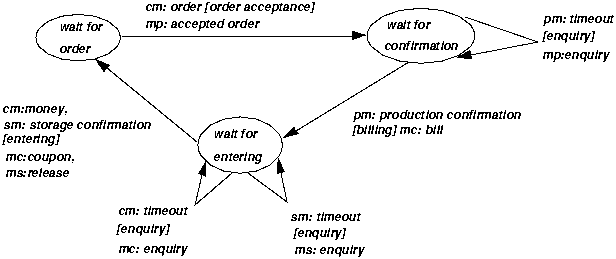Issue
Article
Vol.29 No.1, January 1997
Article
Issue
Issue |
Article |
Vol.29 No.1, January 1997 |
Article |
Issue |
In this extended abstract we discuss the combination of formal and user-centered requirements engineering. Formal methods like Z [Wor92], VDM [AI91], LOTOS, ESTELLE and SDL [Tur93] focus on requirements specification in terms of an abstract behaviour description of the software system to be built. User-centered requirements engineering is concerned with identifying the users of the software system and understanding the tasks to be supported by the system. Here we propose
This work is part of the SYSLAB-project, supported by Siemens Nixdorf and by the Deutsche Forschungsgemeinschaft under the Leibniz program, which aims at a methodology integrating formal and pragmatic software development [Pae95].
In the following we sketch the formal models and a suitable requirements engineering process.
The enterprise is viewed as interacting areas where each area corresponds to a complex task (often, but not necessarily associated with an organisational unit of the enterprise). Thus the enterprise model consists of a task model which describes the areas and their subtasks and an object model which describes the data relevant to these tasks. The behaviour of the tasks is given by state-transition diagrams whose transitions are labelled with triples inputs [subtask] outputs. As an example consider the management of a simple production company shown in Figure 1.
Figure 1: Management of a simple production company

It interacts with the customers (channels cm,mc), the production (channels pm,mp) and the store (channels sm,ms).
The interface model describes the interaction between the user and the software system. On one hand the services of the software-system are identified, where services are the subtasks allocated to the software system. The behaviour of the software system is described in terms of the services. Here again state-transition diagrams are used. On the other hand the objects relevant to the services are collected in the interface object model.
These models are derived from business process scenarios and usage scenarios, which specify exemplary dependencies between tasks and exemplary interactions between users and the software system, respectively.
Altogether we propose the following process for the engineering of functional requirements:
Techniques for modelling processes of the application system have been used in most pragmatic software development techniques (e.g. SSADM [DCC92]). However, these models have been used informally to achieve an understanding of the application. In our approach the emphasis is on a thorough analysis of the enterprise. Both business process scenarios and task behaviour descriptions are first class modelling elements which
Most pragmatic software development methods also use some kind of scenarios to determine the interface of the software system (e.g. FUSION [CAB+94]). But again they are mostly used informally. To our knowledge the only approach making heavy use of usage scenarios is OOSE [Jac92] which is often called "the use-case approach". Use cases are also maintained throughout the development process as independent modelling elements. Thus to some extent our work can be understood as giving a formal basis to Jacobsons' approach.
Similar to the approach of the TASK methodology [BJWZ94] we view the modelling of tasks as the key element of combining requirements analysis methods and user-centered design. The formal interface model is the basis for a detailed user-interface design. The task description by state-transition diagrams can directly be used for prototyping purposes. Another advantage of formality is the possibility of proving important properties of the specification like consistency, safety or liveness.
We have discussed the role of formal enterprise and interface models within the process of user-centered requirements engineering. The approach outlined above is far from complete. The methodological steps leading from the scenarios to the full behaviour descriptions are not fully understood. In [Bro95] the mathematical foundations are sketched. This formal basis should be hidden from the software developer. However, it is essential for powerful tool-support allowing for a thorough validation of the behaviour descriptions.
[AI91] D. Andrews and D. Ince Practical Formal Methods with VDM. Series in Software Engineering. McGraw-Hill, 1991
[BJWZ94] A. Beck, C. Janssen, A. Weisbecker and J. Ziegler. Integrating object-oriented analysis and graphical user interface design. In Software Engineering and Human-Computer Interaction, LNCS 896, pp 127-140. Springer Verlag, 1994.
[Bro95] M. Broy. Mathematical system models as a basis of software engineering. In LNCS 1000. Springer Verlag, 1995.
[CAB+94] D. Colemann, P. Arnold, S. Bodoff, C. Dollin, H. Gilchrist, F. Hayes and P. Jeremaes. Object-Oriented Development -- The FUSION method. Prentice Hall, 1994.
[DCC92] E. Downs, P. Clare, and I. Coe. Structured systems analysis and design method: application and context. Prentice Hall, 1992.
[Jac92] I. Jacobson. Object-oriented Software Engineering. Addison-Wesley, 1992.
[Pae95] B. Paech, A methodology integrating formal and informal software development. In M. Wirsing, editor, ICSE-17 Workshop on Formal Methods Application in Software Engineering Practice, pages 61-68, 1995.
[Tur93] K.J. Turner (ed.), Using formal description techniques -- an introduction to ESTELLE, LOTOS and SDL. John Wiley & Sons, 1993.
[Wor92] J.B. Wordsworth. Software Development with Z. Addison-Wesley, 1992.
Institut für Informatik, Technische Universität München
Arcisstr.21, D-80290; paech@informatik.tu-muenchen.de
Issue |
Article |
Vol.29 No.1, January 1997 |
Article |
Issue |